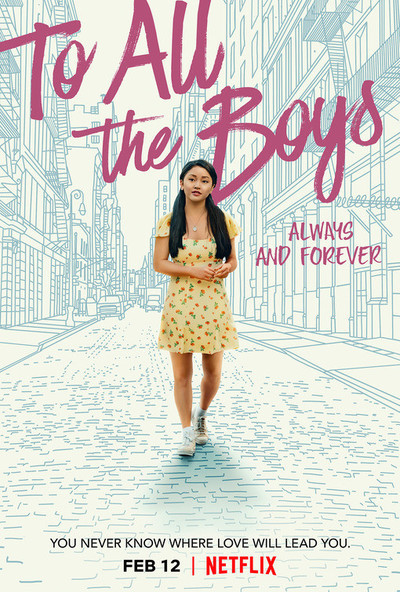“To All the Boys: Always and Forever” stays true to romantic-comedy cliches

Photo courtesy of @lanacondor on Instagram
Released on Feb. 12, 2021, “To All the Boys: Always and Forever” is the third and final film in the popular rom-com series.The film starts halfway through senior year as Lara Jean (Lana Condor) and Peter Kavinsky (Noah Centineo) face the uncertainity of their relationship after high school.
February 24, 2021
The “To All the Boys” franchise comes to a bittersweet conclusion in the third installment “To All the Boys: Always and Forever,” a heartfelt movie that hinges on being excessively sentimental and unrealistic.
When the first movie was released in 2018, social media exploded over the relatability and nostalgia of awkward first love. Three years later, people everywhere are still talking about the love letters that changed the world.
Based on the book series, “To All the Boys: Always and Forever” follows Lara Jean Covey (Lana Condor) and Peter Kavinsky (Noah Centineo) as they struggle to navigate senior year and college decisions. After a family trip to Korea, Lara Jean arrives home eager for her Stanford University application decision—only to find out she was rejected.
As she scrambles for a viable alternative, a new opportunity presents itself on their senior trip to New York. Peter suggests transferring to Stanford after their freshman year, but Lara Jean falls in love with New York City and imagines her life there. The movie dives into themes revolving independence and self-interest, answering the long-awaited question: will the couple survive after high school?
The film opens with stunning shots of Seoul, Korea to showcase Lara Jean’s culture. The scene falls short, though, lasting only a few minutes and only showing brief moments of the family. It feels like a diversity stunt to pacify viewers, and Lara Jean’s Korean culture doesn’t shine through in the rest of the scenes. Her struggle with her cultural identity is noted in a singular line about not fitting in because she doesn’t speak the language. The topic is never revisited, leaving a sense of unfinished business within the series.
However, there are moments where the series’ classic romantic-comedy tropes bring the film together. The scene where Peter holds his phone blasting music outside Lara Jean’s window (borrowed from the movie “Say Anything”) is a cute reminder of the love they share for classic films and romantic gestures. Their meet-cute is mentioned toward the end of the movie, but their adorable first encounter tugs at the heartstrings and solidifies the belief Lara Jean and Peter were always meant to end up together.
The familiar yet ever-vibrant sets and costumes add to the film’s ambience. The costumes are representative of the characters’ identities; Lara Jean’s pastel and colorful clothes are a stark contrast to her best friend Chris’ (Madeleine Arthur) darker clothing choices, representing their two different personalities. But the loss of the ‘90s style more prevalent in the first movie loses the opportunity to further develop the characters.
Take Lara Jean, for example. In the first movie, the platform combat boots hated on by mean girl Gen (Emilija Baranac) are a ‘90s fashion staple and an outward representation of the inner confidence Lara Jean possesses. Now gone in the third movie, her character is stripped of a layer.
Few of the other characters see development from the first films. Despite the messy road over the course of the series, the characters feel too similar to their first appearance and there isn’t much growth.
Then there is also the issue of unrealistic standards. It’s no surprise that film adaptations often change elements of the book. However, by changing the schools from local ones like University of Virginia and William and Mary to elite universities like Stanford and NYU, the film loses an aspect that separates it from traditional rom-coms.
However, as much as it is packed with cliches, “To All the Boys: Always and Forever” does explore the uncertainty of graduation and independence as well as the overwhelming feeling of first love and high school relationships. Though cloying, the film serves as a promise: no matter the obstacles, no matter the distance, love can last: always and forever.

